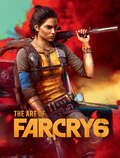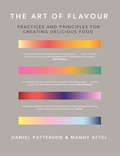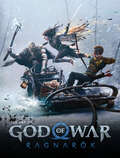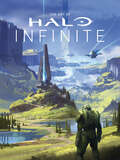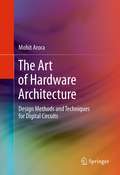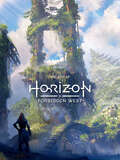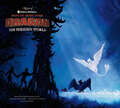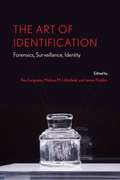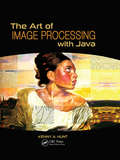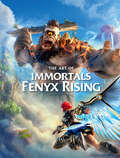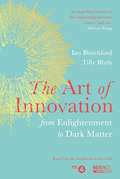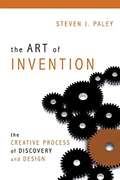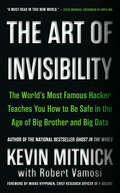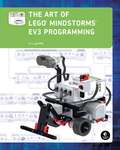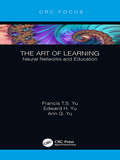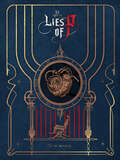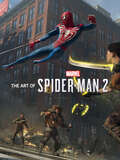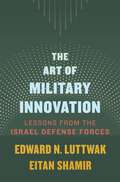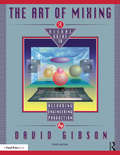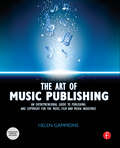- Table View
- List View
The Art of Far Cry 6
by UbisoftExplore the vibrant island of Yara, a nation trapped in time. Dark Horse Books and Ubisoft have joined forces to create The Art of Far Cry 6, a beautiful volume that is perfect for any fan of the Far Cry adventures. Welcome to Yara. Viva Libertad!
The Art of Flavour: Practices and Principles for Creating Delicious Food
by Mandy Aftel Daniel Patterson'Mandy Aftel's latest work with Daniel Patterson is a masterpiece on the science of cooking from an olfactory and culinary perspective through the same lens. This book is a must for any chef or cook looking to find new inspirations and a deeper understanding of the way flavours work together.' Pratap Chahal (@thathungrychef), Flavour Bastard, Soho, London'Am counting down the days till your book arrives!' Nigella LawsonDaniel Patterson, a chef, and Mandy Aftel, a perfumer, present a revolutionary new approach to creating delicious, original food. Aftel and Patterson are rock stars in their respective fields: Patterson has won two Michelin stars for his San Francisco restaurant Coi and numerous James Beard and other food awards, and his new path-breaking co-venture Loco'l is attracting national interest; Aftel has been profiled in the New York Times T Magazine and other publications and is constantly featured and quoted in magazines and blogs. In a world awash with cooking shows, food blogs and recipes, the art of flavour has been surprisingly neglected. The multibillion-dollar flavour industry practises its dark arts by manipulating synthetic ingredients, and home cooks are taught to wield the same blunt instruments: salt, acid, sugar, heat.But foods in their natural states are infinitely more nuanced than the laboratory can replicate - and offer far greater possibilities for deliciousness. Chef Daniel Patterson and natural perfumer Mandy Aftel are experts at orchestrating ingredients, and here they teach readers how to make the most of nature's palette. The Art of Flavour proceeds not by rote formula but via a series of mind-opening and palate-expanding tools and concepts: using a flavour 'compass' to find the way to transformative combinations of aromatic ingredients; pairing ingredients to make them 'bury' (control) one another and 'lock' (achieve an alchemy that transcends the sum of the parts); learning to deploy cooking methods for maximum effect; and the seven 'dials' that allow a cook to fine-tune a dish. With more than sixty recipes that allow the cook to grasp each concept and put it into practice, The Art of Flavour is food for the imagination that will help cooks at any level to become flavour virtuosos in their own right.From The Flavour Bible on, flavour has been a particular focus of recent interest, but no one has Patterson's and Aftel's unique perspective on it, their combined expertise, or their winning blend of ideas, information, recipes and cooking and perfuming lore. The Art of Flavour is a thinking person's cookbook that uses recipes to instil principles for creating delicious food at home, larded with fascinating information on the history and science of flavour that make it a great armchair read as well.
The Art of Ghost of Tsushima
by Sucker Punch ProductionsOn sale date subject to change.A beautifully realized tome inspired by traditional Japanese aesthetics and featuring art from the delicately crafted video game from Sucker Punch Productions. Dark Horse Books and Sucker Punch Productions are honored to present The Art of Ghost of Tsushima. Explore a unique and intimate look at the Tsushima Islands--all collected into a gorgeous, ornately designed art book.Step into the role of Tsushima Island's last samurai, instilling fear and fighting back against the Mongolian invasion of Japan in the open-world adventure, Ghost of Tsushima. This volume vividly showcases every detail of the vast and exotic locale, featuring elegant illustrations of dynamic characters, spirited landscapes, and diagrams of Samurai sword-fighting techniques, along with a look at storyboards and renders from the most intense, eloquent, and expressive cinematic moments of the game.
The Art of God of War Ragnarök
by Amy RatcliffeThe god of war himself returns in this brand-new installment to the beloved God of War series. As the threat of Ragnarök grows ever closer, Kratos and Atreus find themselves choosing between the safety of their family and the safety of the realms. This passionately assembled tome details a story of parenthood, destiny, and adventure in the voices of the team that brought it to life. <p><p> Dark Horse Books and Santa Monica Studio join forces to present stunning, never-before-seen concept art of the world, characters, creatures, and artifacts with The Art of God of War Ragnarök. See what adventures await in Midgard and beyond.
The Art of Halo Infinite
by Microsoft 343 IndustriesThe Master Chief is back. The legendary super soldier returns in Halo Infinite. 343 Industries and Microsoft are building the biggest and most visually spectacular Halo yet. Halo Infinite debuts on the Xbox family of consoles, including Xbox Series X, Microsoft's latest and most powerful game console. To take full advantage of its prodigious graphical prowess, 343 Industries built an all-new, next-generation game engine, giving their world-class artists the tools and technology to realize the worlds, war, and wonder of the Halo universe in unprecedented style and fidelity. 343 Industries have given Dark Horse access to the art and artists who've brought Halo Infinite to vibrant, vivid life. It's all here in unparalleled detail, the heroes you've grown to love--the Master Chief, the brave soldiers of the UNSC, as well as the weapons, vehicles, villains and vistas--and of course, the eponymous and magnificent environments of Halo itself. The Art of Halo Infinite also features a brand-new cover from legendary concept artist and Halo Infinite's Art Director, Sparth! Join us as we take you from concept to launch inside the artwork of the most ambitious Halo game to date.
The Art of Hardware Architecture
by Mohit AroraThis book highlights the complex issues, tasks and skills that must be mastered by an IP designer, in order to design an optimized and robust digital circuit to solve a problem. The techniques and methodologies described can serve as a bridge between specifications that are known to the designer and RTL code that is final outcome, reducing significantly the time it takes to convert initial ideas and concepts into right-first-time silicon. Coverage focuses on real problems rather than theoretical concepts, with an emphasis on design techniques across various aspects of chip-design.
The Art of Horizon Forbidden West
by Guerrilla GamesA dynamic full-color hardcover featuring concept art and creator commentary chronicling the development of the next adventure in the epic Horizon saga.When a mysterious red blight threatens to strangle all life, the heroic young Aloy must tackle new dangers in the mysterious frontier of the Forbidden West in order to save her world. The highly anticipated sequel to Horizon Zero Dawn has finally arrived, and with it, all new vibrant landscapes, jaw-dropping machines, and thrilling secrets to discover. Follow Aloy on her next adventure with this beautiful chronicle created by Dark Horse Books in association with Guerrilla Games! The Art of Horizon Forbidden West uncovers the mysteries of a lost world with all new behind-the-scenes artwork and intimate developer commentary. Relive the unforgettable tale.
The Art of How to Train Your Dragon: The Hidden World
by Linda SunshineIn this brilliantly illustrated, full-color book, Dark Horse Books and DreamWorks Animation join forces to celebrate the climatic third film showcasing more adventures of Toothless and Hiccup. Featuring hundreds of pieces of original art and commentary from director Dean De Blois and the many talented artists and filmmakers who have created this masterpiece of storytelling and animation.A beautifully designed hardcover volume featuring exclusive commentary and never-before-seen art from the creation of the animated motion picture masterpiece!Don your winged Flight Suit, grab your Dragon Blade, hop on your obedient Night Fury, and get ready for the ride of a lifetime with your favorite dragons and Vikings in the latest installment in the How to Train Your Dragon trilogy! Fans will delight in the discovery of previously unknown dragons, the threat of a heartless villain, and the quest for sanctuary that propels the story to extraordinary new heights (and depths!). Venture into the Hidden World where dragons roam free under the watchful eye of their leader Toothless as, above ground, Hiccup struggles to assume leadership of his tribe.
The Art of Identification: Forensics, Surveillance, Identity (AnthropoScene)
by Rex Ferguson, Melissa M. Littlefi eld and James PurdonSince the mid-nineteenth century, there has been a notable acceleration in the development of the techniques used to confirm identity. From fingerprints to photographs to DNA, we have been rapidly amassing novel means of identification, even as personal, individual identity remains a complex chimera. The Art of Identification examines how such processes are entangled within a wider sphere of cultural identity formation.Against the backdrop of an unstable modernity and the rapid rise and expansion of identificatory techniques, this volume makes the case that identity and identification are mutually imbricated and that our best understanding of both concepts and technologies comes through the interdisciplinary analysis of science, bureaucratic infrastructures, and cultural artifacts. With contributions from literary critics, cultural historians, scholars of film and new media, a forensic anthropologist, and a human bioarcheologist, this book reflects upon the relationship between the bureaucratic, scientific, and technologically determined techniques of identification and the cultural contexts of art, literature, and screen media. In doing so, it opens the interpretive possibilities surrounding identification and pushes us to think about it as existing within a range of cultural influences that complicate the precise formulation, meaning, and reception of the concept.In addition to the editors, the contributors to this volume include Dorothy Butchard, Patricia E. Chu, Jonathan Finn, Rebecca Gowland, Liv Hausken, Matt Houlbrook, Rob Lederer, Andrew Mangham, Victoria Stewart, and Tim Thompson.
The Art of Identification: Forensics, Surveillance, Identity (AnthropoScene: The SLSA Book Series #9)
by Rex Ferguson, Melissa M. Littlefi eld and James PurdonSince the mid-nineteenth century, there has been a notable acceleration in the development of the techniques used to confirm identity. From fingerprints to photographs to DNA, we have been rapidly amassing novel means of identification, even as personal, individual identity remains a complex chimera. The Art of Identification examines how such processes are entangled within a wider sphere of cultural identity formation.Against the backdrop of an unstable modernity and the rapid rise and expansion of identificatory techniques, this volume makes the case that identity and identification are mutually imbricated and that our best understanding of both concepts and technologies comes through the interdisciplinary analysis of science, bureaucratic infrastructures, and cultural artifacts. With contributions from literary critics, cultural historians, scholars of film and new media, a forensic anthropologist, and a human bioarcheologist, this book reflects upon the relationship between the bureaucratic, scientific, and technologically determined techniques of identification and the cultural contexts of art, literature, and screen media. In doing so, it opens the interpretive possibilities surrounding identification and pushes us to think about it as existing within a range of cultural influences that complicate the precise formulation, meaning, and reception of the concept.In addition to the editors, the contributors to this volume include Dorothy Butchard, Patricia E. Chu, Jonathan Finn, Rebecca Gowland, Liv Hausken, Matt Houlbrook, Rob Lederer, Andrew Mangham, Victoria Stewart, and Tim Thompson.
The Art of Image Processing with Java
by Kenny A. HuntThis introductory image processing text is ideal for college students studying computer science or software engineering. With an emphasis on software design, the text builds on an accessible mathematical foundation and on extensive sample Java code to teach students the fundamentals of image processing. The text is accompanied by rich illustrations that demonstrate the results of performing processing on famous art pieces. This approach gives readers real-world examples of ways they may use image processing. Each chapter includes problems for students, and an online supplement offers instructor resources.
The Art of Immortals: Fenyx Rising
by UbisoftA fanciful full-colored tome chronicling the development of the hotly anticipated video game Immortals Fenyx Rising(TM) from Ubisoft EntertainmentThe creative team of Ubisoft Quebec presents a fantastical world based on mythological tales, rife with creatures such as bestial minotaur, gigantic cyclops, evil chimera, ferocious harpies, and the terrifying Medusa. This volume offers an inside look at the craft behind that massive and magical land, wherein readers will find themselves taking part in a heroic journey that spans the lush paradisiacal lands of Aphrodite the goddess of love, through the scarred battlefield and fortress of Ares the god of war, up Mount Olympus--home of the mighty Zeus, down into the darkest corners of the underworld. and much more! Not only does this book lend insights into designs of Fenyx, a new winged Greek hero, with their legendary weapons and armor, but also the environments that players will explore, the creatures they will encounter and--most importantly--the gods themselves, who seek aid against the fearsome titan and father of all monsters, Typhon! The Art of Immortals Fenyx Rising gives readers unique insights into the masterful development of a memorable gaming experience. This collection of concept art and creator commentary is sure to engage any fan of games, art, or ancient myth!
The Art of Innovation: From Enlightenment to Dark Matter, as featured on Radio 4
by Ian Blatchford Tilly BlythBased on the landmark Radio 4 series, this beautifully illustrated modern history of the connections between science and art offers a new perspective on what that relationship has contributed to the world around us. __________ Throughout history, artists and scientists have been driven by curiosity and the desire to experiment. Both have wanted to make sense of the world around them, often to change it, sometimes working closely together, certainly taking inspiration from each other's disciplines. The relationship between the two has traditionally been perceived as one of love and hate, fascination and revulsion, symbiotic but antagonistic. But art is crucial to helping us understand our science legacy and science is well served by applying an artistic lens. How exactly has the ingenuity of science and technology been incorporated into artistic expression? And how has creative practice, in turn, stimulated innovation and technological change?The Art of Innovation is a history of the past 250 years viewed through the disciplines of art and science. Through fascinating stories that explore the sometimes unexpected relationships between famous artworks and significant scientific and technological objects - from Constable's cloudscapes and the chemist who first measured changes in air pressure, to the introduction of photography and the representation of natural history in print - it offers a new way of seeing, studying and interpreting the extraordinary world around us.
The Art of Invention: The Creative Process of Discovery and Design
by Steven J. PaleyIn this entertaining and insightful exploration of the process of invention, an experienced inventor vividly illustrates how great inventions embody three crucial characteristics--simplicity, elegance, and robustness. Whether you're an aspiring inventor or an experienced designer, the author's expertise, personal examples, and case studies offer detailed guidance on conceptualizing your ideas and turning them into reality. The author shows how ideas can come from a variety of sources such as the natural world, basic physical principles, life experience, or even chance observations. He examines how intuition and the harnessing of subconscious information are key ingredients for the inventive process. He concludes with an in-depth look at the business of invention and the typical inventor's toolkit. He addresses the real-world challenges of turning a good idea into a practical, marketable application, including patents, marketing, and entrepreneurship. He is candid about the realities of hard work and the need to learn from the inevitable mistakes along the way. Full of insights and practical guidance from a successful inventor and entrepreneur, this book will open new avenues of creativity for budding and accomplished inventors alike.
The Art of Invisibility: The World's Most Famous Hacker Teaches You How to Be Safe in the Age of Big Brother and Big Data
by Kevin MitnickBe online without leaving a trace.Your every step online is being tracked and stored, and your identity literally stolen. Big companies and big governments want to know and exploit what you do, and privacy is a luxury few can afford or understand. In this explosive yet practical book, Kevin Mitnick uses true-life stories to show exactly what is happening without your knowledge, teaching you "the art of invisibility"--online and real-world tactics to protect you and your family, using easy step-by-step instructions. Reading this book, you will learn everything from password protection and smart Wi-Fi usage to advanced techniques designed to maximize your anonymity. Kevin Mitnick knows exactly how vulnerabilities can be exploited and just what to do to prevent that from happening. The world's most famous--and formerly the US government's most wanted--computer hacker, he has hacked into some of the country's most powerful and seemingly impenetrable agencies and companies, and at one point was on a three-year run from the FBI. Now Mitnick is reformed and widely regarded as the expert on the subject of computer security. Invisibility isn't just for superheroes--privacy is a power you deserve and need in the age of Big Brother and Big Data.
The Art of KeyForge
by AsmodeeA fantastic full-color digital book that features a staggering array of artwork--all from the massively popular card game!Explore the Crucible and the distinct houses of KeyForge through a gorgeously designed collection of the game's masterfully created art! At the center of the KeyForge universe stands an enigmatic world built from the disparate pieces of countless planets, where players must use their unique decks of cards to unlock mysterious hidden Vaults! This vibrant art book explores KeyForge's contest of power and wit with hundreds of illustrations that demonstrate the countless possibilities that are available across every deck, showcasing the whimsical and exciting art in glorious detail! This tome is a must-have for readers ranging from the most dedicated Archons to casual fans of games and science-fantasy! Join the legions of players who've made this game a smash success, and witness the Crucible for yourself!
The Art of LEGO MINDSTORMS EV3 Programming
by Terry GriffinWith its colorful, block-based interface, The LEGO® MINDSTORMS® EV3 programming language is designed to allow anyone to program intelligent robots, but its powerful features can be intimidating at first. The Art of LEGO MINDSTORMS EV3 Programming is a full-color, beginner-friendly guide designed to bridge that gap.Inside, you’ll discover how to combine core EV3 elements like blocks, data wires, files, and variables to create sophisticated programs. You’ll also learn good programming practices, memory management, and helpful debugging strategies—general skills that will be relevant to programming in any language.All of the book’s programs work with one general-purpose test robot that you’ll build early on. As you follow along, you’ll program your robot to:–React to different environments and respond to commands–Follow a wall to navigate a maze–Display drawings that you input with dials, sensors, and data wires on the EV3 screen–Play a Simon Says–style game that uses arrays to save your high score–Follow a line using a PID-type controller like the ones in real industrial systemsThe Art of LEGO MINDSTORMS EV3 Programming covers both the Home and Education Editions of the EV3 set, making it perfect for kids, parents, and teachers alike. Whether your robotics lab is the living room or the classroom, this is the complete guide to EV3 programming that you’ve been waiting for.Requirements: One LEGO MINDSTORMS EV3 Home OR Education set (#31313 OR #45544).
The Art of Learning: Neural Networks and Education
by Francis T.S. Yu Edward H. Yu Ann G. YuThis book presents the idea that innovative ways of teaching and learning are very essential to retention and growth. Presented in 15 sections, the book starts with the common sense training on education and moves on to neural network operation. Throughout the book, the art of learning, associative, cognitive, and creative learning are stated and defined. Learning simplicity, information content as related to neural network learning are discussed. The author also discusses neural plasticity and adaptability in smarter neural networks. If we know our human brain’s basic abilities and limitation then a better educational methods can be implemented. Presents the idea that innovative ways of teaching and learning are very essential to retention and growth Discusses major differences and constraints between neural network and computer Presents the significances of learning simplicity and information content as related to neural network learning are included Stresses the neural network learning capabilities and limitations and their role in developing more efficient learning techniques
The Art of Lies of P
by NEOWIZ ROUND8 StudioAn oversized full-color art book chronicling the making of the hit video game.Geppetto&’s puppet is trapped in a web of lies. Fierce monsters and devious figures stand between the would-be real boy and the truth: who unleashed the plague that has plunged the once prosperous city of Krat into madness and blood lust?In Lies of P, an embattled puppet must adapt his weapons and his body to face untold horrors, untangle unfathomable secrets, and confront the consequences of both honesty and deceit.Dark Horse and ROUND8 Studio invite readers to explore this mysterious and thrilling world through a lovingly assembled collection of concept art, accompanied by intimate creator commentary. The Art of Lies of P is a darkly fantastic journey through the creation of the video game sensation.
The Art of Manufacturing: Overcome control challenges for increasing efficiency in manufacturing using real-world examples
by Ninad Deshpande Sivaram PothukuchiDemystify automation and solve control-related problems with the help of real-world products and case studies put together by two industrial automation expertsKey FeaturesReal life applications and case studies of automation curated from authors rich experienceOvercome tricky automation and control issues in the manufacturing processImplement automation in manufacturing for higher efficiency and productivity in the industryBook DescriptionEngineering disciplines focus mainly on programming control systems, while the challenges they overcome or their industry applications largely go uncovered, leaving a huge gap between the theory and industry practices. This leads to engineers learning about subjects without actually understanding their purpose and entering the industry needing months of training.The Art of Manufacturing cuts across pedantic theory and reaches practical applications. You'll begin your learning journey by starting from the product and moving backward to the manufacturing landscape, factories, machines, and finally to the automation and control challenges faced in manufacturing. The book builds on the authors' valuable on-field experience, providing a detailed view of the manufacturing of real-world products, while simultaneously providing various analogies and references to daily tasks. As you advance through the chapters, you'll work on interesting control problems and find out how to overcome them in applications. The concluding chapters offer you a sneak peek into the future of automation and factories.By the end of this book, you'll be able to relate a real-world product with an associated control challenge and discover ways to overcome these challenges.What you will learnUnderstand the role of machines, factories, and plants in manufacturing a productExplore the manufacturing landscape and its continuous evolutionUse practical applications to mitigate control challenges in manufacturingResolve implementation challenges of various applications in a machineDiscover how humans and automation work together in factoriesFind out how to solve the same control challenge in different waysDiscover links between Industry 3.0, Industry 4.0, digitalization, and lean manufacturingWho this book is forThe book will interest an inquisitive student of engineering (electrical, electronics, mechatronics, E&TC) who wishes to explore beyond the classroom textbook content. It will also serve as a teacher's handbook helping the lecturer bring the flair of industry into the classroom. Moreover, it will be useful for a practicing engineer, with cross-disciplinary knowledge that is needed to manufacture any real product. You must have basic knowledge of electronics, electrical, and mechatronics (engineering).
The Art of Marvel's Spider-Man 2
by Insomniac GamesWeb-sling into action with an oversized hardcover art book chronicling the development of Marvel&’s Spider-Man 2 through never-before-seen concept art and intimate creator commentary.Peter Parker and Miles Morales return for an exciting new adventure in the critically acclaimed Marvel&’s Spider-Man video game saga. As the inimitable web-heads swing, jump, and glide across Marvel&’s New York, the iconic villains threaten to destroy their lives, their city, and the ones they love. Now readers can explore the creation of this dynamic new entry in the Spider-Man video game series—from unforgettable characters, extraordinary equipment, breathtaking locales, thrilling storyboards, and more—all accompanied by comments from the game&’s creative team!Dark Horse Books and Marvel Games have joined forces to present The Art of Marvel&’s Spider-Man 2. This passionately designed volume celebrates the art and artistry behind the Wall-Crawlers and their exploits, and provides fascinating insights to amaze any Spider-Fan!
The Art of Measuring in the Thermal Sciences (Heat Transfer)
by Michel De Paepe Josua P. MeyerThe Art of Measuring in the Thermal Sciences provides an original state-of-the-art guide to scholars who are conducting thermal experiments in both academia and industry. Applications include energy generation, transport, manufacturing, mining, processes, HVAC&R, etc. This book presents original insights into advanced measurement techniques and systems, explores the fundamentals, and focuses on the analysis and design of thermal systems. Discusses the advanced measurement techniques now used in thermal systems Links measurement techniques to concepts in thermal science and engineering Draws upon the original work of current researchers and experts in thermal-fluid measurement Includes coverage of new technologies, such as micro-level heat transfer measurements Covers the main types of instrumentation and software used in thermal-fluid measurements This book offers engineers, researchers, and graduate students an overview of the best practices for conducting sound measurements in the thermal sciences.
The Art of Military Innovation: Lessons From The Israel Defense Forces
by Edward N. Luttwak Eitan ShamirA world-leading military strategist and an IDF insider explain the improbable success of the Israeli armed forces.When the Israel Defense Forces was established in May 1948, it was small, poorly equipped, and already at war. Lacking sufficient weaponry or the domestic industrial base to produce it, the newborn military was forced to make do with whatever it could get its hands on. That spirit of improvisation carried the IDF to a decisive victory in the First Arab-Israeli War.Today the same spirit has made the IDF the most powerful military in the Middle East and among the most capable in the world. In The Art of Military Innovation, Edward N. Luttwak and Eitan Shamir trace the roots of this astounding success. What sets the IDF apart, they argue, is its singular organizational structure. From its inception, it has been the world’s only one-service military, encompassing air, naval, and land forces in a single institutional body. This unique structure, coupled with a young officer corps, allows for initiative from below. The result is a nimble organization inclined toward change rather than beholden to tradition.The IDF has fostered some of the most significant advances in military technology of the past seventy years, from the first wartime use of drones to the famed Iron Dome missile defense system, and now the first laser weapon, Iron Beam. Less-heralded innovations in training, logistics, and human resources have been equally important. Sharing rich insights and compelling stories, Luttwak and Shamir reveal just what makes the IDF so agile and effective.
The Art of Mixing: A Visual Guide to Recording, Engineering, and Production (Mix Pro Audio Ser.)
by David GibsonDavid Gibson uses 3D visual representations of sounds in a mix as a tool to explain the dynamics that can be created in a mix. This book provides an in-depth exploration into the aesthetics of what makes a great mix. Gibson’s unique approach explains how to map sounds to visuals in order to create a visual framework that can be used to analyze what is going on in any mix. Once you have the framework down, Gibson then uses it to explain the traditions that have be developed over time by great recording engineers for different styles of music and songs. You will come to understand everything that can be done in a mix to create dynamics that affect people in really deep ways. Once you understand what engineers are doing to create the great mixes they do, you can then use this framework to develop your own values as to what you feel is a good mix. Once you have a perspective on what all can be done, you have the power to be truly creative on your own – to create whole new mixing possibilities. It is all about creating art out of technology. This book goes beyond explaining what the equipment does – it explains what to do with the equipment to make the best possible mixes.
The Art of Music Publishing: An entrepreneurial guide to publishing and copyright for the music, film, and media industries
by Helen GammonsDo you want to pursue a career and succeed in the lucrative area of music publishing? The Art of Music Publishing provides real inspiration and a tangible hands on perspective to this exciting side of the high-risk, high-reward music business. Prepare yourself for a career in music publishing and understand this complex but profitable part of the music business. Author Gammons walks you through all you need to know * understanding the role of the publisher * copyright * managing rights * income streams * contracts*. Learn how, when and where income is generated in all the current areas of business as well as exploring the new industries offering new income streams and the business models that are developing. The supporting website includes video interviews and podcasts with music business legends. 'If there is anything that Helen Gammons doesn't know about music publishing, it's probably not worth knowing! If you want to take it to the next level in music publishing - read this book. I know I'll be referring to it often.'David 'Hawk' WolinskiComposer of "Aint No Body" (Rufus and Chaka Khan) and one of the most covered songs ever. "Whether you're already a music publisher or would like to be one, this book will give you a mass of useful information - fresh ideas, up-to-date legal opinions, video interviews with music biz legends, provocative thoughts about where the business is heading, and plenty of good anecdotes."From Simon Napier Bell Manager: The Yardbrids, George Michael and Wham, Marc Bolan. Japan.
